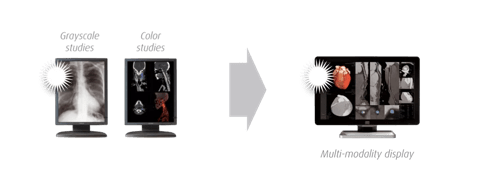What is a diagnostic display?
A diagnostic display is a monitor that meets the high demands of medical imaging in radiology and mammography. It is used by radiologists to view diagnostic images, such as X-rays, MRIs, CT scans and more. Diagnostic displays come with special tools and technologies to help radiologists make a swift and accurate diagnosis.
Diagnostic displays help increase a radiologist’s productivity
Diagnostic displays feature a large display form factor, which allows flexible positioning of multiple images on the screen with fewer manipulations. High calibrated light and image-enhancing features enable faster detection of subtle details. Ideally, a diagnostic display allows viewing of different modalities, in grayscale and in color, on a single screen. This eliminates the need to change workstations or displays during reading sessions.

Diagnostic displays are medical-grade displays with built-in features that automate routine tasks – such as Barco’s clinical workflow tools – can make reading more efficient, aiding faster diagnosis. Software for automated Quality Assurance & calibration is a must. This way, uptime of all diagnostic displays can be ensured with no interruptions to the radiologist’s workflow.
Diagnostic displays help increase a radiologist’s reading comfort
The large display form factor typical of diagnostic displays allows for flexible, more ergonomic viewing of diagnostic images on one screen. This also helps to reduce image manipulations (and occupational injuries) as radiologists can position images just the way they want (whether in the center of the display or over the entire screen).
When the display has a wide viewing angle (at least 178°), it also decreases the need for substantial head and eye movements. Special built-in features can adjust the display brightness to the ambient light for optimal reading conditions. Last but not least, diagnostic displays usually come with a non-reflective glass cover, which is easy on the eyes.

Diagnostic displays enhance a radiologist’s diagnostic confidence
Thanks to their sharp image quality, incl. contrast, color/grayscale accuracy, luminance uniformity & stability, diagnostic displays can achieve the best possible image on screen. In case of a high-precision integrated luminance photometer, in combination with QA and calibration software, radiologists can rely on stable, DICOM-compliant images over time. This is important to ensure accurate diagnoses.
Additional built-in features, such as Barco's SpotView tool, can further enhance the brightness and contrast, unveiling the most subtle details in a radiology image.
Conclusion
With a diagnostic display, radiologists – whether they specialize in mammography, pediatric, emergency, cardiac, neuro, interventional or general radiology – can rely on impeccable images and smooth workflow, always, so they can ensure the best clinical care for their patients.
Interested in more?
Discover our full diagnostic imaging portfolio here.
